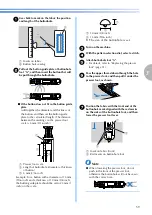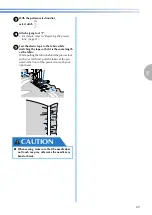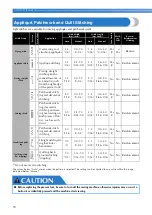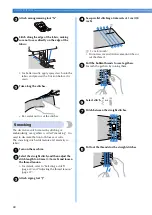
UTILITY STITCHES
————————————————————————————————————————————————————————————————————
72
Piecing
Sewing together two pieces of fabric is called
“piecing”. The fabric pieces should be cut with a 6.5
mm (1/4 inch) seam allowance.
Sew a piecing straight stitch 6.5 mm (1/4 inch) from
the right side of the presser foot.
a
Baste or pin along the seam allowance of the
fabric that you wish to piece together.
b
Turn on the machine.
c
Select stitch
.
• For details, refer to “Selecting a stitch”
(page 40).
d
Attach zigzag foot “J”.
• For details, refer to “Replacing the presser
foot” (page 31).
e
Sew with the side of the presser foot aligned
with the edge of the fabric.
■
For a seam allowance on the right side
Align the right side of the presser foot with
the edge of the fabric, and sew using stitch
.
a
6.5 mm (1/4 inch)
Memo
●
To change the width of the seam allowance
(the needle position), adjust the stitch width.
Quilting
Sandwiching batting between the top and bottom
layers of fabric is called “quilting”. Quilts can easily
be sewn using the optional walking foot and the
optional quilting guide.
a
Baste the fabric to be quilted.
b
Attach the walking foot.
• For details, refer to “Using the optional
walking foot” (page 33).
c
Select a stitch.
• For details, refer to “Selecting a stitch”
(page 40).
d
Place one hand on each side of the presser
foot, and hold fabric taut while sewing.
Note
●
Thread the needle manually when using the
walking foot, or only attach the walking foot
after threading the needle using the needle
threader.
●
When quilting, use a 90/14 home sewing
machine needle.
●
When sewing with the walking foot, sew at
a speed between slow and medium.
■
Using the optional quilting guide
Use the quilting guide to sew parallel stitches that
are equally spaced.
J
1
Summary of Contents for 885-V15
Page 2: ......
Page 112: ...English 885 V15 Printed in China XF6232 001 ...
















































